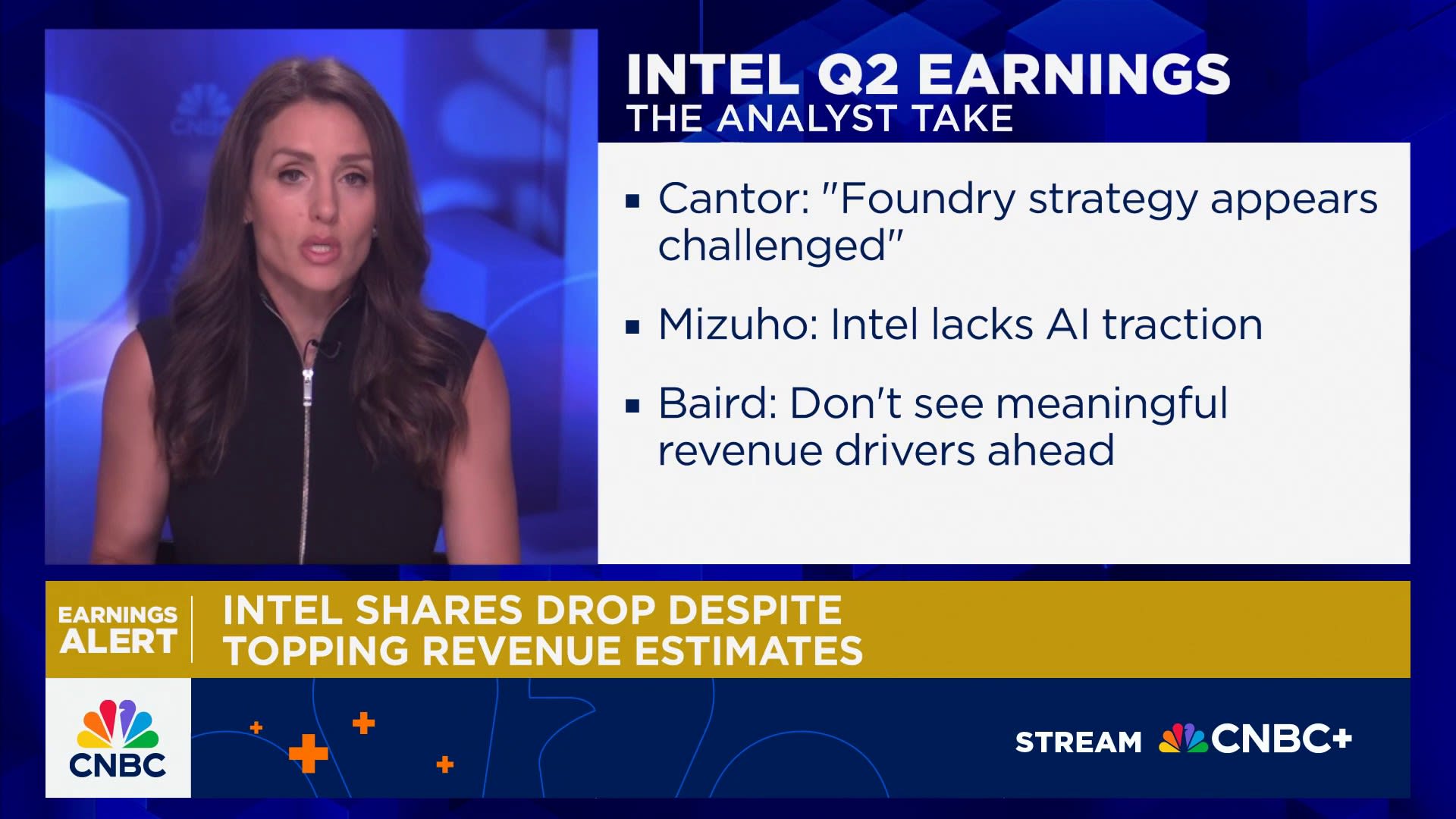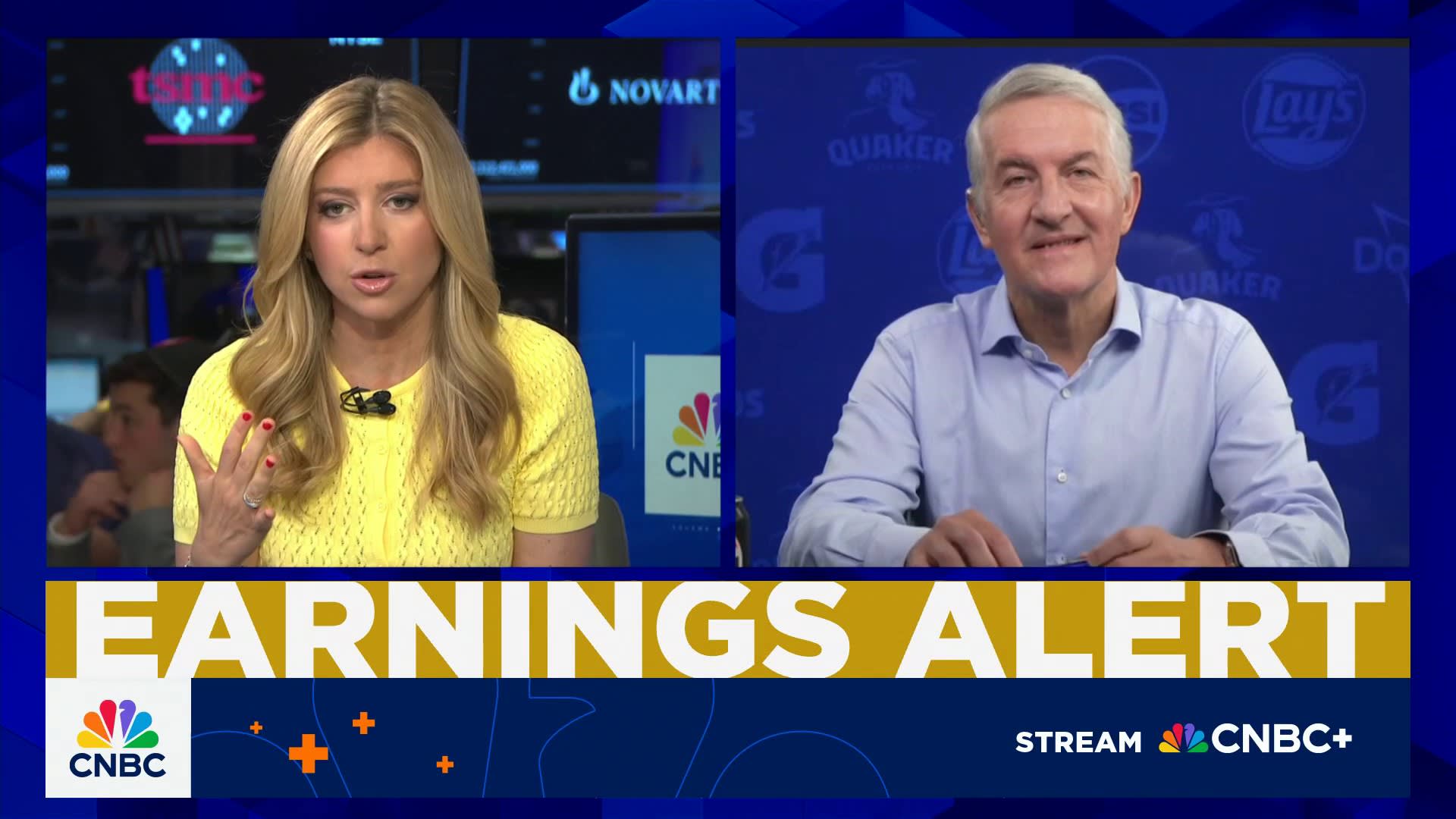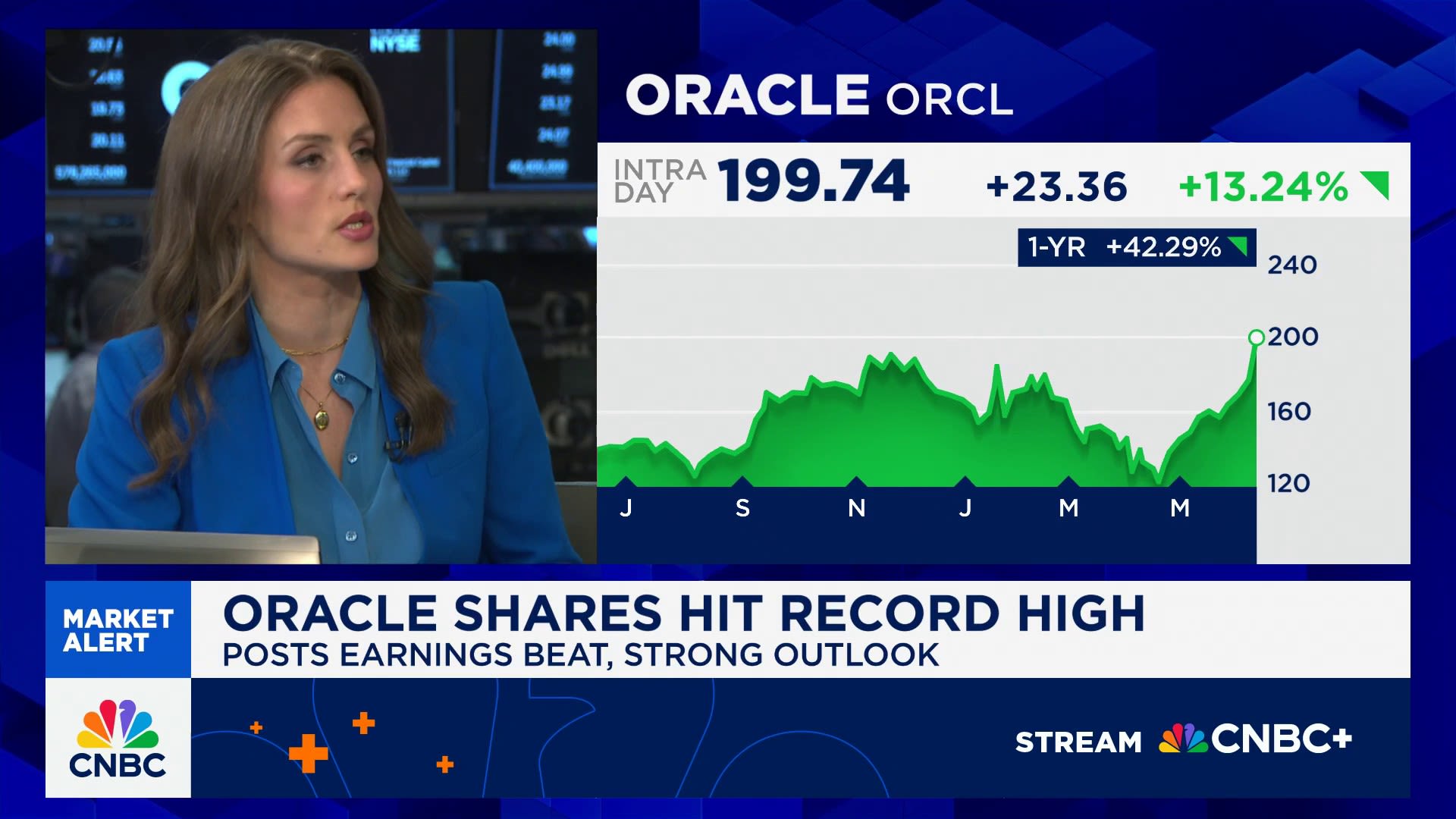President Donald Trump last week increased the pressure on Apple over foreign-made iPhones in a scathing social media post that also intensified the overall stock market sell-off. In the week ahead, another great American tech giant — Club name Nvidia — will be in the spotlight. Following trade optimism the prior week, the S & P 500 went right back into the soup, with a weekly drop of 2.6%. The Nasdaq fell nearly 2.5% last week. Both of those weekly drops were the worst in more than a month. Apple was our worst-performing stock of the week, down almost 7.6%. Apple also fell out of the $3 trillion U.S. market capitalization club, now occupied only by portfolio names Microsof t and Nvidia. During last Wednesday’s May Monthly Meeting for Club members, Jim Cramer said Apple was the stock he was most concerned about . He listed four others on his worry list and six stocks to buy right now . Trump on Friday reminded Wall Street that he’s in charge and willing to be an “administrator of pain,” as Jim put it , to bring manufacturing back to the United States. He capped the trading week by saying iPhones not made in the U.S. should be subject to a 25% tariff. Friday afternoon, he said that tariff would also apply to Samsung and other smartphone makers. The president on Friday also called for 50% tariffs on the European Union, starting June 1. On Sunday, he delayed the rollout of the EU levies until July 9, and European stocks rebounded Monday. The U.S. stock market was closed Monday for Memorial Day. .SPX .IXIC 5D mountain S & P 500 vs. Nasdaq 5 days Last week’s fresh trade barbs overshadowed continued progress on U.S. tariff talks with China. The world’s two largest economies agreed on May 12 to pause the triple-digit levies on each other’s imports in pursuit of a broader trade agreement. The only trade deal that has come from Trump’s “reciprocal” tariff fight came on May 9 with the United Kingdom. It looked like the market last week was willing to look past Moody’s downgrade of U.S. government debt over concerns about the federal budget deficit and the cost of financing existing debt. The Moody’s one-notch decline from its highest rating happened after the market closed on May 16 and followed similar moves from Fitch in 2023 and Standard & Poor’s in 2011. However, the passage in the GOP-controlled House this week of Trump’s “Big Beautiful Bill” by just one vote took the stock market lower on concerns that the package of tax cuts and spending would worsen the country’s fiscal situation. Putting pressure on stocks was the spike in bond yields, which saw the 10-year Treasury yield briefly go back to mid-February highs above 4.6%. The 10-year yield finished the week above 4.5%. The budget legislation goes to the Senate, where Republicans also have a slim majority. One thing is for sure: the S & P Short Range Oscillator on Wednesday ended a run of 18 straight sessions in overbought territory. We had raised cash during this period as our discipline mandates. When the Oscillator, our trusted market momentum indicator, is overbought, we look to trim our stock exposure. On the flip side, we feel better about buying when the Oscillator is more neutral or oversold. In Friday’s sell-off, we added to our Capital One position — a stock Jim called one of the most exciting positions in the portfolio because of the Discover acquisition, which brings significant strategic and financial benefits . On Thursday, with the Oscillator in a more neutral position, we bought more shares of Eli Lilly , which has dropped more than 20% month to date on concerns about possible tariffs on overseas manufacturing, a presidential executive order targeting lower drug prices, and Novo Nordisk starting a GLP-1 pricing war. On Monday, we were a little ahead of the Oscillator’s turn, adding to GE Vernova on some weakness. Later in the week, GE Vernova, our newest position, hit an all-time high and was our best performer of the week, with a gain of 8.5%. There were also three Club earnings reports last week, including TJX Companies , the off-price retail giant behind T.J. Maxx, Marshalls, and HomeGoods. Its results were quite respectable, but the stock dropped in response anyway. We used that as an opportunity to upgrade our rating on the stock to our buy-equivalent 1 and lifted our price target to $145 a share from $140. A pair of Club names reported quarterly results last Tuesday. Palo Alto Networks’ numbers, which came after the close, underwhelmed, and the stock dropped nearly 7% the next day. We don’t think the quarter raised any long-term or fundamental concerns, so we reiterated our $225 price target and hold-equivalent 2 rating. The stock bounced Thursday and Friday. Home Depot, which delivered earnings before Tuesday’s open, checked the most important boxes for investors despite an earnings miss. We, however, reiterated our 1 rating and $400 price target. The stock ended up falling every day last week, as the move in bond yields didn’t do mortgage rates any favors. Investors want to see lower mortgage rates to spark housing activity and Home Depot’s business. The economic calendar is fairly light in the holiday-shortened week, while we will once again hear from a trio of Club names. 1. Inflation data: The Federal Reserve’s preferred inflation gauge — the personal consumption expenditures price (PCE) index — is due out Friday. It’s the main economic report of the week. While the consumer price index (CPI) typically gets more attention, the Fed believes the PCE does a better job of capturing how consumers are actually spending their money, particularly in response to price changes. The data on Friday will be for the month of April, a month that consisted of rapid changes in U.S. tariff policy. Some economists took down their forecasts for the PCE index after last week’s CPI report and the producer price index (PPI) came in cooler than expected. While the dynamic nature of Trump’s trade policy makes it difficult to predict the future path of inflation, the hope is that it continues trending downward toward 2% , which could give the Fed the confidence it needs to lower interest rates. The central bank has been taking a wait-and-see approach during the trade war, despite Trump publicly calling for rate cuts. 2. Nvidia earnings : The biggest earnings report of the week — not just in our portfolio, but in the market overall — is Nvidia’s on Wednesday night. As usual lately, Nvidia’s guidance may be the biggest driver of the stock reaction. We saw in late February that shares were dinged because its guidance did not exceed expectations by the same magnitude that investors had come to expect during the generative AI boom. A key variable to Nvidia’s outlook this time around is the Trump administration’s China AI chip ban, which took effect in April and forced Nvidia to book a $5.5 billion inventory charge on its made-for-China H20 processors. While the consensus estimate for Nvidia’s July quarter revenue has come down since early April, some analysts believe the H20 restrictions aren’t appropriately baked into revenue expectations. That makes the setup a bit tricky. Additionally, does the evolving China picture complicate Nvidia’s outlook for gross margin expansion later this year as the launch of Blackwell generation chips matures? China headwinds aside, Nvidia stock is in a much better spot heading into the report than it was a month ago, thanks to its American tech giant customers reaffirming their AI investment plans and a wave of new “sovereign AI” customers in the Middle East coming into the fray. We expect that analysts will be looking for color from Nvidia CEO Jensen Huang and CFO Colette Kress on the financial implications of these sovereign deals, which were announced during Trump’s recent visits to Saudi Arabia, Qatar, and the United Arab Emirates. How lucrative could these new markets really be? As challenging as Trump’s geopolitical approach has been for Nvidia’s China business, Middle East chip deals represent the other, positive side of the coin. Other potential topics of conversation on the call include Nvidia’s vision for its new networking product called NVLink Fusion . With all these different crosscurrents and the way the stock has bounced back so much, it’s hard to feel at ease going into the report, as Jim noted during Friday’s Morning Meeting. Here’s what analysts are expecting, according to LSEG estimates: Revenue: $43.21 billion EPS: $0.88 3. Salesforce earnings : Salesforce is also out Wednesday night. The No. 1 thing that we’ll be looking for is updates on the adoption of its AI products: Data Cloud and the newer Agentforce. Last quarter, we heard that Salesforce has 3,000 paying Agentforce customers and another 2,000 non-paying trial deals. Where are those numbers now? A few more metrics to watch are current remaining performance obligation (cRPO) — future revenue under contract that is expected to be recognized within the next 12 months — and adjusted operating margin. In February, Salesforce guided for cRPO growth of 10% in the quarter and full-year adjusted operating margin of 34%. More generally, we’ll be looking for color from CEO Marc Benioff and CFO Robin Washington on how the evolving economic environment is impacting customers’ willingness to commit to deals. Like with Nvidia, Jim said he is worried about Salesforce, but he hopes that signs of traction for Agentforce could offset any blemishes elsewhere in the report. Any commentary about ServiceNow ‘s entrance into Salesforce-dominated customer relationship management would be welcome. Revenue: $9.75 billion EPS: $2.54 4. Costco earnings : Costco reports on Thursday night, and there should hopefully not be many fireworks considering the retailer’s track record of consistency and the fact that its monthly sales reports provide visibility into the state of the quarter in advance of the actual earnings release. At the same time, though, a lot of the good news ends up being priced into Costco’s stock by the time earnings come around, so shares are known to trade lower on the print. Admittedly, the sell-off on earnings in March was a bit more dramatic than we’re used to seeing. As with all retailers, tariffs will be a big topic on Thursday’s earnings call — how has the company’s supply chain responded to the events of recent months, and how has customer buying behavior changed, if at all? We’ll also be keeping an eye on Costco’s margins and updates on its advertising and e-commerce initiatives. Revenue: $63.19 billion EPS: $4.24 Week ahead Monday, May 26 U.S. stock market closed for Memorial Day Tuesday, May 27 Census Bureau’s new orders for manufactured durable goods at 8:30 a.m. ET The Conference Board’s Consumer Confidence Index at 10 a.m. ET Before the bell: Pinduoduo (PDD), AutoZone (AZO), Bank of Nova Scotia (BNS), After the bell: Okta (OKTA), Box (BOX), Semtech Corp. (SMTC), Chemical & Mining Co. of Chile (SQM) Wednesday, May 28 Federal Open Market Committee’s Meeting Minutes at 2 p.m. ET Before the bell: Dick’s Sporting Goods (DKS), Abercrombie & Fitch (ANF), Macy’s (M), Bank of Montreal (BMO), Capril Holdings (CPRI), Kingsoft Cloud Holdings (KC), VNET Group (VNET) After the bell: Nvidia (NVDA) , Salesforce (CRM) , C3.ai (AI), e.lf. Beauty (ELF), Agilent Technologies (A), SentinelOne (S), nCino (NCNO), Pure Storage (PSTG), Synopsys (SNPS), Veeva Systems (VEEV), HP Inc. (HPQ), U-Haul (UHAL), Nordson Corp (NDSN) Thursday, May 29 Second reading of first-quarter GDP at 8:30 a.m. ET Initial jobless claims at 8:30 a.m. ET National Association of Realtor’s Pending Home Sales Index at 10 a.m. ET Before the bell: Foot Locker (FL), Best Buy (BBY), Kohl’s Corporation (KSS), Burlington Stores (BURL), Canadian Imperial Bank of Commerce (CM), Hormel Foods (HRL), Build-A-Bear Workshop (BBW), Bath & Body Works (BBWI), BRP Inc. (DOOO), Li Auto (LI), Royal Bank of Canada (RY), SpartanNash (SPTN) After the bell: Marvell Technology (MRVL), Costco Wholesale (COST), Dell Technologies (DELL), American Eagle Outfitters (AEO), Gap Inc. (GAP), ULTA Beauty (ULTA), Zscaler (ZS), CooperCompanies (COO), PagerDuty (PD), NetApp (NTAP), UiPath (PATH), Red Robin Gourmet Burger (RRGB) Friday, May 30 Personal Consumption Expenditures Price Index at 8:30 a.m. ET University of Michigan’s Consumer Sentiment Index (final reading) at 10 a.m. ET Before the bell: Canopy Growth (CGC), Shoe Carnival (SCVL) (See here for a full list of the stocks in Jim Cramer’s Charitable Trust.) As a subscriber to the CNBC Investing Club with Jim Cramer, you will receive a trade alert before Jim makes a trade. Jim waits 45 minutes after sending a trade alert before buying or selling a stock in his charitable trust’s portfolio. If Jim has talked about a stock on CNBC TV, he waits 72 hours after issuing the trade alert before executing the trade. THE ABOVE INVESTING CLUB INFORMATION IS SUBJECT TO OUR TERMS AND CONDITIONS AND PRIVACY POLICY , TOGETHER WITH OUR DISCLAIMER . NO FIDUCIARY OBLIGATION OR DUTY EXISTS, OR IS CREATED, BY VIRTUE OF YOUR RECEIPT OF ANY INFORMATION PROVIDED IN CONNECTION WITH THE INVESTING CLUB. NO SPECIFIC OUTCOME OR PROFIT IS GUARANTEED.
President and CEO of Nvidia Jensen Huang speaks at a forum at the U.S. Capitol in Washington, DC on April 30, 2025.
Kevin Dietsch | Getty Images News | Getty Images
President Donald Trump last week increased the pressure on Apple over foreign-made iPhones in a scathing social media post that also intensified the overall stock market sell-off.
In the week ahead, another great American tech giant — Club name Nvidia — will be in the spotlight.










